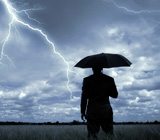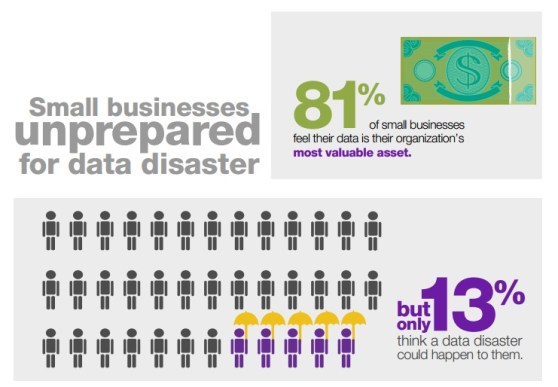This sponsored post is by Peter Lamson, SVP of Small Business at Carbonite, a leading online backup provider for consumers and small to medium sized businesses.
Hurricanes. Fires. Equipment failure. Theft. What would you do if your company’s emails, billing records, customer files, inventory reports, payroll, and tax information suddenly disappeared? If you’re unsure, you should probably create a disaster preparedness plan. Now is the perfect time to get started, as September is National Preparedness Month!
A study conducted by Carbonite showed that only 13 percent of small business owners think a data disaster could happen to them and 54 percent believe a data disaster was unlikely to affect their business. But having a solid plan in place is critical for small businesses, as research from the Insurance Information Institute states that up to 40 percent of small businesses affected by disaster will never reopen.
Is your company prepared in the event of a disaster? Take a look at our checklist to find out:
Develop a written, documented disaster preparedness plan
Work with your team leaders (office managers, IT, security, sales, etc.) to create a detailed, written plan of action that makes sense for your company. Include emergency contact information for all employees and vendors, and make sure to keep a copy offsite. That document will be no help to you if it’s in a desk you can’t get to!
Communicate your disaster preparedness plan
Who ya gonna call? Sadly, the Ghostbusters won’t be able to help you in a disaster. Make sure everyone within your company knows how to communicate with each other, can determine employee safety, and is aware of his or her responsibility in maintaining operations. Hold a company-wide meeting to review the plan in detail, and make sure everyone has a written and electronic version of the most recent plan.
Share your plan with critical external contacts
Your internal team may be prepared, but your hardware, software, facilities, and service vendors are critical to your business too. Be sure you can get in touch with them — chances are you’ll need to. For example, what if you have products shipped to your office? Are your vendors willing and able to ship them elsewhere? Most likely, they will bend over backwards to assist you, but they won’t be able to if they aren’t aware of your plan.
Designate an alternative site of operation
Do you have another location where key employees can conduct critical business functions in the event of a disaster? Ideally, you would identify at least two separate locations, one of which should be at least an hour away from your current location. This will increase the likelihood that you will be able to communicate with employees and customers throughout a disaster.
Review your current backup plan
Disasters tend to strike when they are least expected, instantly wiping out a significant amount of data. Small businesses say that data is their most valuable asset, but many small businesses only back up files once or twice a month, which can result in tremendous loss. Online backup is the best way to ensure you get all your files back easily in the result of a disaster. Online backup providers keep your files protected by automatically and continually creating copies of all your files and storing them in the cloud, whereas storage and syncing services will only protect the files you’ve manually selected to save to the cloud. Look for an online backup provider that will allow you to remotely access the files in your backup from nearly any internet-connected device, which can help keep you connected in an emergency.
Back up your data constantly
Make sure you use a service that works automatically and continually in the background. Doing so can do more than save you money; it can literally save your company. Look for a service that transmits your protected files offsite to secure severs to ensure your files are safe from theft, fire, spills, power spikes, power outages, physical accidents, and just about anything else that might happen to your office.
Make a plan to recover your files
When disaster strikes, the internet may not be available. A good data backup service should be prepared to assist you if this is the case. Should you find yourself in this situation, you will want to have a service that can ship you a portable hard drive containing all of your backed up files. Make sure the service you use offers high-caliber customer support so that you can be walked through the process of recovering your files, which can prove particularly helpful during a high-stress moment or if key IT members from your own company are unavailable.
Establish a chain of command
What if your top executives are unreachable during the time of disaster? In addition to an offsite crisis meeting and work place(s) for employees, it is vital to select and train additional employees to perform emergency operations in their absence. Training is important; you don’t want to end up with a Dwight Schrute office emergency situation.
Do a dry run
Practice makes perfect. While it may generate some eye-rolling, companies that walk through a simulation have a far greater chance of successful recovery. Employees are less likely to panic when they are familiar with the plan. And even more importantly, a simulation allows flaws to be noticed — and fixed — before disaster strikes.
Keep your plan current
If your plan is out of date, it is essentially useless. For example, it doesn’t do your employees any good to show up at your alternate office site if it went out of business a year ago, and an out-of-date plan could mean you’re calling vendors you no longer work with (awkward!). Ideally, your plan would be updated annually or each time major changes are made.
Some final thoughts
While your company’s disaster preparedness plan will be unique based on your own business needs, the above tips will help you assess, document and execute your disaster plan so your business can be up and running as soon as possible after a disaster. Though the plan we’ve outlined here is do-it-yourself, it may make sense for you to bring on professionals for some elements, such as IT and security, depending on your company’s resources. Though we all hope to never need to use a disaster plan, you’ll never regret having one. If you’re interested in learning more about how to protect your valuable data, check out our recent webinar on DIY disaster prep, start a free trial at www.carbonite.com, or give us a call at 877-BACK IT UP (we’re ready and willing to help!).
VentureBeat's mission is to be a digital town square for technical decision-makers to gain knowledge about transformative enterprise technology and transact. Learn More


